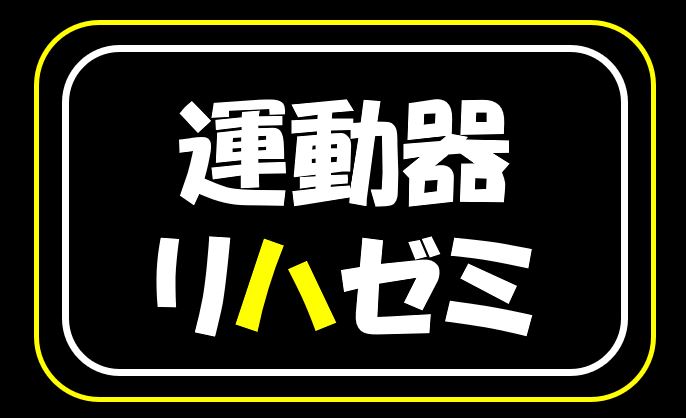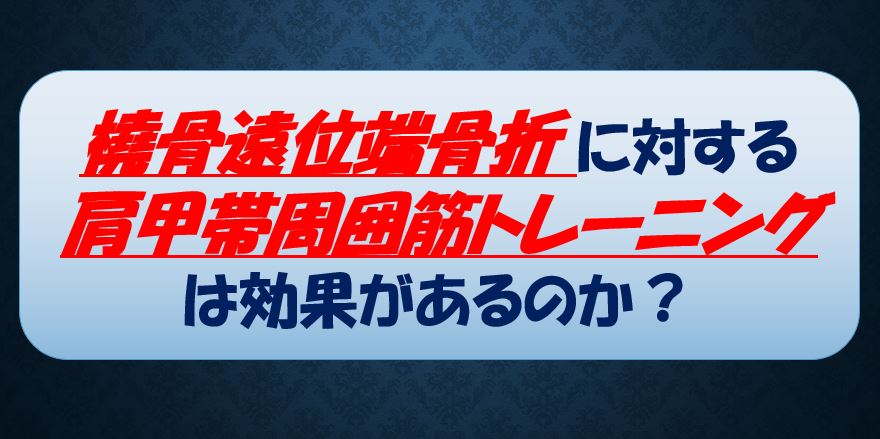こんにちは!
運動器専門のリハビリスタッフです!!
いつもお世話になります。
今回は、『橈骨遠位端骨折に対する肩甲帯周囲筋トレーニングは効果があるのか?』
について解説させていただきます。
橈骨遠位端骨折は転倒した際に手をついて発生することが多く、高齢者の4大骨折のうちの一つとされています。
特に骨粗鬆症があると発生しやすくなるとされています。
超高齢社会に突入する日本においては、今後ますます増加傾向になることが予測されます。
また、橈骨遠位端骨折は以下に示す条件において、発生リスクが高いとされています。
・女性
・骨粗鬆症や骨量減少
・グルココルチコイド使用歴あり
・血清ビタミンD低値
・中手骨における骨皮質の多孔性や橈骨遠位端部の骨微細構造の劣化
・片脚起立時間15秒未満
・氷晶雨や路面の凍結、低気温といった気象
など
そんな中、2017年に、橈骨遠位端骨折術後早期の肩甲帯周囲筋トレーニングは効果があるのかを検討した論文が海外で報告されております。
この論文の検証結果が気になるところですね。
◆論文紹介
Randomized Controlled Trial
Acta Chir Orthop Traumatol Cech (IF: 0.53; Q4)
. 2017;84(2):114-119.
[The Effect of Activation of the Shoulder Girdle Muscles on Functional Outcomes of Rehabilitation in Patients with Surgically Treated Distal Radius Fractures]
[橈骨遠位端骨折の外科的治療を受けた患者における肩甲帯周囲筋の活性化がリハビリテーションの機能的アウトカムに与える影響】について]
[Article in Czech]
V Jančíková 1, J Opavský, P Dráč, A Krobot, I Čižmář
Affiliations expand
• PMID: 28809628
Abstract
PURPOSE OF THE STUDY The aim of the study was to assess the functional outcomes of rehabilitation in patients with surgically treated distal radius fractures in the early postoperative period.
概要
研究の目的 本研究の目的は、外科的治療を受けた橈骨遠位端骨折患者の術後早期におけるリハビリテーションの機能的成果を評価することであった。
We compared the functional outcomes of patients undergoing standard rehabilitation with the group of patients whose postoperative rehabilitation was extended with shoulder girdle exercises of the affected upper limb while the wrist was immobilized. Several indices and variables were used for the assessment of the functional therapeutic outcomes of the affected wrist.
標準的なリハビリテーションを受けた患者と、手関節を固定したまま患側上肢の肩甲骨の運動で術後リハビリテーションを延長した患者群の機能的転帰を比較検討した。手関節の機能的治療成績の評価には、いくつかの指標と変数を用いた。
MATERIAL AND METHODS Forty patients (32 females and 8 males, the mean age 60.5 years) with distal radius fractures treated by internal fixation using volar surgical approach were involved in the study between 2013-2016. The tested subjects were randomized and split into two groups according to the selected method of rehabilitation. The tested subjects with standard rehabilitation extended with shoulder girdle muscles activation were labelled as group I. It included patients (n = 20) of the mean age 59.8 (age range 42-73 years) with immobilized wrist (i.e. for 3-4 weeks) performing shoulder girdle muscles exercises at the same time. Furthermore, standard kinesiotherapy continued after their fixation was removed. The other tested group, labelled as group II (n = 20), the mean age 61.3 (variation 40-74 years of age) involved patients with distal radius fractures. Only standard rehabilitation was performed in this group as late as their forearm fixation was removed. The following indices and parameters were assessed in the early postoperative period (i.e. by 8 weeks after the fixation removal): wrist and fingers range of motion (ROM), hand grip strength (dynamometry), local swelling, pain, scores of a nine hole peg test (NHPT), and a DASH score.
方法 2013年から2016年の間に、橈骨遠位端骨折を掌側アプローチで内固定した40名の患者(女性32名、男性8名、平均年齢60.5歳)を研究に参加させた。試験対象者は、選択したリハビリテーションの方法に従って無作為に2群に分けられた。手関節を固定した平均年齢59.8歳(年齢範囲42~73歳)の患者(n=20)が、肩甲帯周囲筋エクササイズを同時に行ったもので、肩甲帯周囲筋の活性化を伴う標準的なリハビリテーションを行った被験者をグループIと名付けた。さらに、固定を解除した後も標準的な運動療法を継続した。もう1つの試験群はII群(n=20)で、平均年齢61.3歳(ばらつき40~74歳)、橈骨遠位端骨折の患者を対象としたものである。この群では、前腕の固定が外れた時点で、標準的なリハビリテーションのみが行われました。術後早期(固定除去後8週間まで)に以下の指標とパラメータを評価した:手関節と指の可動域(ROM)、手の握力、局所腫脹、疼痛、nine hole peg test(NHPT)のスコア、およびDASHスコア。
RESULTS After the fixation had been removed, the group I reported statistically significantly higher values of movement compared to the values of the contralateral limb in the following directions: dorsal flexion, palmar flexion, MP joints flexion, flexion of PIP joints (proximal interphalangeal), and flexion of DIP joints (distal interphalangeal). After eight weeks, the group I manifested significantly higher values in dorsal flexion, palmar flexion and ulnar deviation in the wrist. There were no significant differences in other movement directions. The hand grip strength mean value examined with a dynamometer was significantly higher in the group I in the sixth and eighth week of testing (group I – 58.9% strength of a healthy limb after six weeks, or 66.5% after eight weeks). The results in the group II were 49.9% strength of a healthy limb after six weeks, or 56.6% after eight weeks. The group I showed statistically significantly lower values of wrist swelling and higher finger dexterity in the NHPT in all measured weeks. Lower pain intensity in the group I during the measurements was observed. At the same time, this group showed significantly better results in the DASH score.
結果 固定除去後、I群は背屈、掌屈、MP関節屈曲、PIP関節(近位指節間関節)屈曲、DIP関節(遠位指節間関節)屈曲の方向で対側肢の値に比べて統計的に有意に高い運動量を報告した。8週間後、I群は手関節の背屈、掌屈、尺側偏位で有意に高い値を示した。その他の運動方向には有意差は認められなかった。ダイナモメーターで調べた手の握力の平均値は、6週目と8週目にI群で有意に高かった(I群-6週目で健常肢の58.9%、8週目で66.5%の強度)。II群では、6週間後の健常肢の筋力が49.9%、8週間後の筋力が56.6%という結果であった。Ⅰ群はすべての測定週において、NHPTで指の巧緻性も高く、手首の腫れの値が統計的に有意に低かった。また、I群では測定中の痛みの強さがより低いことが確認された。同時に、このグループはDASHスコアにおいて有意に良好な結果を示した。
DISCUSSION The results of this study are useful for clinical practice. They confirm a functional relation between the activity of hand muscles and the shoulder muscle activity. The differences in the functional ability of the hand and the functional state of the injured wrist were detected as early as in the early postoperative period. It could be stated that the tested subjects in the group I showed a greater and faster improvement in the physical function of the injured hand. This was also accompanied by a positive psychological effect. We had not found a study of a similar type in the available literature that we could have compared our submitted results to.
考察 本研究の結果は、臨床に有用である。手指の筋活動と肩の筋活動の間に機能的な関係があることが確認された。手指の機能的能力の差と負傷した手関節の機能的状態の差は、術後早期の段階で検出された。I群の被検者は、負傷した手の身体的機能において、より大きく、より速い改善を示したと言える。このことは、心理的な効果も伴っていた。私たちが提出した結果と比較できるような、類似のタイプの研究は、利用可能な文献にはありませんでした。
◆論文の結論
CONCLUSIONS Shoulder girdle muscles exercises after a distal radius fracture, while wrist is immobilized, can evidently enhance functional capability and accelerate the hand-function restitution. Early functional outcomes of the injured wrist after the rehabilitation with shoulder girdle muscles exercises support the efficiency of this broadened rehabilitation protocol. Key words: distal radius frac,ture, hand, shoulder, functional treatment, rehabilitation
結論 橈骨遠位端骨折後、手関節を固定した状態で肩甲帯周囲筋を鍛えることは、明らかに機能的能力を高め、手指の機能回復を促進させることができる。肩甲帯周囲筋群のリハビリテーションを行うことで、手関節の早期機能回復が期待でき、このような幅広いリハビリテーションプロトコルの有効性を支持する。
◆まとめ
上記論文では掌側アプローチが施行され、術後にギプス固定加療を行った橈骨遠位端骨折術後患者40名(女性32名、男性8名、平均年齢60.5歳)を対象としております。
対象者をギプス固定中から肩甲帯周囲筋エクササイズを実施し、ギプス固定除去後も標準的リハビリを継続した群(肩甲帯群)20名とギプス固定除去後から標準的なリハビリを実施した群(対照群)20名の2群に振り分けて、ギプス固定中の肩甲帯周囲筋エクササイズの効果を検証しております。
術後早期(固定除去後8週間まで)に手関節と指の可動域(ROM)、手の握力、局所腫脹、疼痛、nine hole peg test(NHPT)スコア、およびDASHスコアを評価しております。
結果として、ギプス固定除去後ではⅠ群
固定除去後、肩甲帯群は背屈、掌屈、MP関節屈曲、PIP関節(近位指節間関節)屈曲、DIP関節屈曲の方向で対側肢の値に比べて有意に高い数値であったそうです。
また、固定除去8週間後でも肩甲帯群は手関節の背屈、掌屈、尺側偏位で有意に高い値を示したとのことです。
手の握力は、固定除去後6週目と8週目に肩甲帯群が有意に高かったそうです。
また肩甲帯群ではすべての測定週においてNHPTの手の巧緻性が高く、手関節の腫れの値が有意に低かったとのことです。
また、肩甲帯群ではDASHスコアが有意に良好で、測定中の痛みの強さがより低いことも確認されているそうです。
上記論文の結果を踏まえると、ギプス固定中から肩甲帯周囲筋エクササイズをすると、術後の疼痛、関節可動域、機能面など様々な比較において、良好な成績であることがわかりました。
橈骨遠位端骨折後のギプス固定中は患部に対して、リハビリを実施する項目が少ない中で、患部外練習として、肩甲帯周囲筋エクササイズの有効性が認められた貴重な報告ではないかと思われます。
今回は、『橈骨遠位端骨折に対する肩甲帯周囲筋トレーニングは効果があるのか?』
について解説させていただきました。


![[商品価格に関しましては、リンクが作成された時点と現時点で情報が変更されている場合がございます。] [商品価格に関しましては、リンクが作成された時点と現時点で情報が変更されている場合がございます。]](https://hbb.afl.rakuten.co.jp/hgb/1f7a7439.6deab8a7.1f7a743a.315603be/?me_id=1213310&item_id=21195057&pc=https%3A%2F%2Fthumbnail.image.rakuten.co.jp%2F%400_mall%2Fbook%2Fcabinet%2F4386%2F9784260054386_1_4.jpg%3F_ex%3D240x240&s=240x240&t=picttext)


